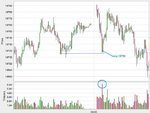SOCRATES
Veteren member
- Messages
- 4,966
- Likes
- 136
The big mystery...is always a big mystery if there are two main elements missing in order to facilitate a solution. The first is incomplete information...😆 ...and the second is where a scenario could be interpreted to mean different things and hence produce different outcomes.
And when these outcomes turn out to be the opposite to the ones expected it would not occur to anyone to disregard the underlying causes but to review what if any information is missing ..😆
The difficulty often is that on occasion candlestics behave perfectly and develop perfectly in line with expectatons and at other times they do not, the reason for this being imperfect interpretation, because no one in his right mind is going to go out of his way to get it persistently wrong on purpose.
This is not necessarily the fault of the observer, it is because of the way markets are constructed and are made to operate.
And when these outcomes turn out to be the opposite to the ones expected it would not occur to anyone to disregard the underlying causes but to review what if any information is missing ..😆
The difficulty often is that on occasion candlestics behave perfectly and develop perfectly in line with expectatons and at other times they do not, the reason for this being imperfect interpretation, because no one in his right mind is going to go out of his way to get it persistently wrong on purpose.
This is not necessarily the fault of the observer, it is because of the way markets are constructed and are made to operate.

